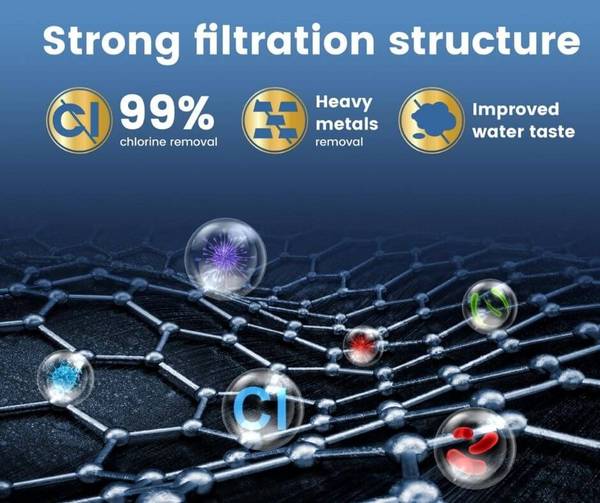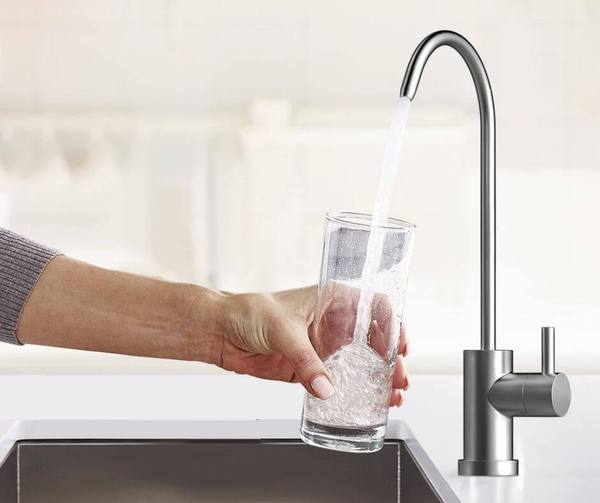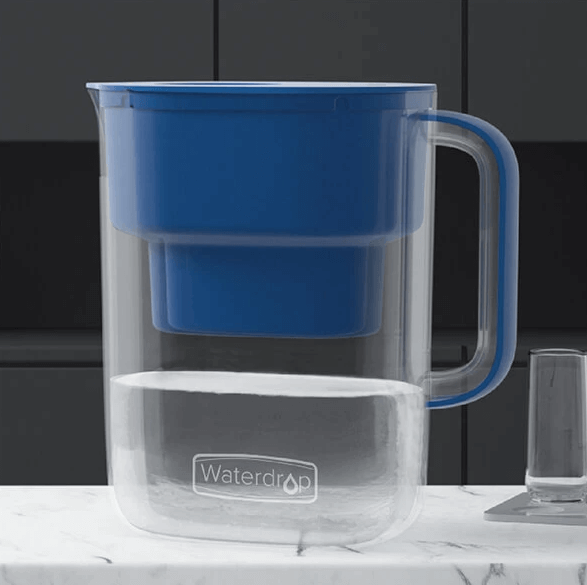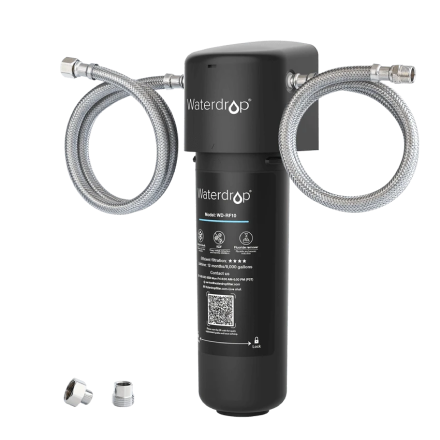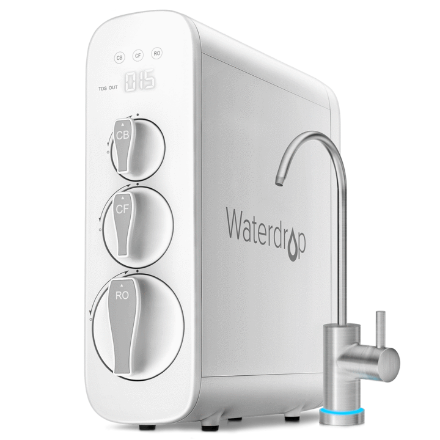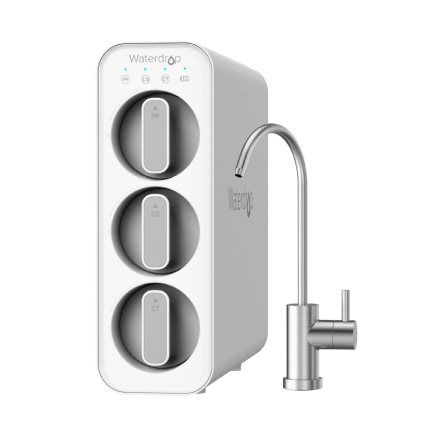Every household deserves clean and great-tasting water for both indoor and outdoor
use. Read about under sink water filters and how they work to deliver high quality water.
What is an under-sink water filter?
The need for
clean, drinkable water
is increasing by the day. As a result, the purification industry has continued to provide more efficient ways of
turning unclean water into clean, usable water by removing contaminants. One of these ways is the use of under
sink water filter. As one of the point-of-use, water filter for sink is installed right at the place where you
get water. It connects right on your water line, and water is filtered directly through faucet or through
refrigerator. For many people who do not need a whole house water filtration system, under-sink water filter may
be a good choice for pure and healthy water.
Who should buy an under-sink water filter?
More homeowners are joining the under-sink water filter users train – for the
obvious reasons. It offers a highly-efficient filtration process that removes harmful contaminants, leaving you
with
clean,
filtered water for cooking and drinking. It is also less cumbersome and works ‘on-demand.'
Are you still doubting if your household needs the a better water filter? Let's
make the decision easier for you. An under-sink water filter is one way of getting purer water for your home,
and you should get it if you are interested in a filtration option that works individually with each sink
instead of the entire household supply.
Another reason to get an under-sink water filter is if you have limited space to
house a filtration unit. Under-sink water filter units are known for their smaller sizes. Hence, they are
suitable for both large and small homes, and even flats without any significant intrusion. You will be surprised
to see that most of these units can be fitted in a closed cabinet.
Under-sink water filters are affordable – both for purchase and maintenance. You
can quickly get the replacement filters around for low prices, and they work efficiently as the new models.
Maintaining an under-sink water filter unit is a simple DIY. You can worry less about inviting plumbers and
electricians every time. All you have to do is adhere to the instructions and guidance provided in the manual.
Are you worried about the increasing number of empty
water bottles in your home? You should! This litters the environment and also
poses a significant threat to the environment in the form of pollution. Spend less on water bottles and drink
clean, filtered water whenever you want by getting an under-sink water filtration unit. You will only need to
refill a few bottles with the home filtered water if you are leaving home and need some water.
Lastly, the filtered water from under-sink water filters is known for its great
taste. This is a good reason to consume more water, after all, the taste is great and the feeling
super-refreshing. Filtered water from these units are free of odor and contaminants but retains useful minerals
that contribute to the taste.
Types of under sink water filters
Now that you are familiar with the impressive benefits of under-sink water filters
and convinced your home deserves one, the next question is: Which type of under-sink water filter to go for? As
you would expect, a setup as beneficial as an under-sink water filter will come in various forms. This section
will intimate you with the different types and put you in a better position to decide which is ideal for your
home and use.
Reverse osmosis systems
Specific under-sink filtration units rely on the principle of reverse osmosis to
filter unclean water for drinking and other domestic use. They are ideal for feed water containing harmful
dissolved contaminants such as
Volatile
Organic Compounds (VOCs),
Arsenic and other heavy metals, Chlorine, and
sediments.
The reverse osmosis process is quite thorough and detailed, thanks to its multiple
stages of filtration controlled by different forms of filters. There are
carbon filters,
sediment filters, and remineralization filters (in some cases). There is also the reverse osmosis membrane,
which specializes in filtering off dissolved particles that will ordinarily be missed by other kinds of filters.
So, if you are in the market for a thorough under-sink filtration unit that leaves
no stone unturned, RO systems are the way to go. That being said, you may have to spend more if you are using it
as your whole house water treatment solution because you will need additional equipment like
a storage tank and a large
booster pump. Regardless of
the higher cost, under-sink reverse osmosis filter remains an excellent under-sink filtration solution.
Ultrafiltration systems
An
under-sink ultrafiltration filter unit is an excellent means of getting clean and home
filtered water from feed water with harmful dissolved contaminants. Unlike other under-sink water filtration
units, the ultrafiltration systems
retain
the minerals during the filtration process. How does it do this?
These units are fitted with an ultrafiltration membrane. It can easily filter off
most of the same contaminants as the RO membrane, while keeping the dissolved minerals intact. Dissolved
minerals can offer considerable health benefits.
So, if you want the beneficial minerals to be retained in your home filtered water,
this unit is right for you.
You do not have to worry about getting additional equipment and fixtures in the
case of under-sink ultrafiltration systems. They work fine with just the home water pressure while reducing
wastewater to the high level possible.
Carbon water filters
There are under-sink carbon filters, specially designed to filter off odors,
chlorine, chloramines, and bad tastes from the tap water, leaving you with clean, odorless, and great-tasting
water in the end. These units come with a carbon filter that relies on the principle of adsorption to get rid of
organic substances from tap water. The contaminants and chemicals in the feed water are stuck on the surface of
the filter. In some cases, the carbon filter may use mechanical filtration to filter off cysts and lead.
Despite its ability to provide great tasting water free of chlorine, under-sink
carbon filter units are unable to remove dissolved substances. So, you may only consider them if you are sure
your tap water has no Arsenic, VOCs, and other harmful contaminants that are usually dissolved in water.
All of these under sink water filter types are quite affordable, can be installed
easily, requires little maintenance, and will help you save considerably on a whole-home filtration system and
water-related expenses like bottled water and plumbing works.
Why should you install an under-sink water filter?
You may decide you have no business installing an under-sink water filter in your
home. But before you do so, ask yourself – Do I need clean and great-tasting water in my home? If yes, the next
question is, how can I make this possible without breaking the bank? The answer to the second question is simple
– install the right water filter system in your home.
Installing a suitable under-sink water filtration unit in your home is the right
bet because:
- It is affordable.
- It offers efficient performance.
- It is mobile and requires little space.
Under-sink water filtration systems are affordable
Under-sink water filters are one of the most affordable filtration options out
there in the current market. You will save money on both the initial purchase and subsequent maintenance. You
may need to replace filters as and when due, but even at that, filter replacements – the biggest maintenance
aspect – are available in stores around you and at affordable prices.
Under-sink home water filtration systems are highly efficient
They remove chemicals and other harmful contaminants in tap water and provide clean
water using just the constant and strong water pressure of your home. The important part? Some filtration
systems retains the natural minerals your body needs to stay super healthy, and which also contribute to the
great taste of the filtered water.
Under-sink water filtration systems are mobile
Mobility is another top advantage of installing an under-sink home water filtration
system in your home. While other units with similar functions – distillation devices – require ample space
because of the need to be paired up with other filters, under-sink water filtration units work alone and
requires no much space. So, if you have no ample space in your home to accommodate a big water filtration unit,
under-sink water filters are your go-to option. They can easily fit under your kitchen sink, leaving you with
space for other essential kitchen appliances and use.
Advantages and disadvantages of under-sink water filters
So far, we have sung the under-sink water filter units' praises and emphasize why
you should get them. But are they 100% flawless? Let's find out by taking an extensive look at the pros and cons
of under sink water filters.
Pros of under-sink water filters
It requires minimal storage space. Despite its importance, not everyone has much
space to spare for most home water filtration systems out there. This is where under-sink water filters come
handy. They slot in easily under the kitchen sink – as the name implies. It helps you to save space, compared to
what you would have coughed up for a whole house filtering system.
It improves water quality. Under-sink water filters are known for turning out home
filtered water of high quality. It removes all the
contaminants found in tap water and does this right in the kitchen – the
point of high amount of water use.
It is easy to install. One of the fears homeowners face when it comes to buying a
water filtration unit is the complex installation. Under-sink water filter units do not put you in this
challenging situation. You can install any under-sink water filter even with minimum capabilities. Likewise,
there are tons of resources online – videos, manuals, and illustrations to help you, or better still consult the
manual included by the manufacturer.
It requires minimal maintenance. No one wants a unit that will drain them and their
pockets in the name of maintenance. Under-sink water filter units are not one of them. The major maintenance
need is always the filter replacement – another easy and affordable DIY.
It is eco-friendly. Environmental pollution is a menace we are all trying to
combat. An under-sink water filter unit provides filtered, clean, drinkable water that can be stored in empty,
reusable insulated
water
bottles. This removes the need to buy more bottled water or accumulate empty plastic
products.
It comes in various makes and models. You cannot run out of options when it comes
to under-sink water filters. You will find a wide variety of them in the market, with each designed based on the
number of contaminants they can remove. For starters, they are largely classified as standard or advance.
It is affordable. This list of advantages will be incomplete without mentioning the
reasonable prices of these essential units. Even with the extra expenses for maintenance, the average under-sink
water filter system is a rewarding investment both in the long and short run.
Cons of under-sink water filters
It is not all perfect with under-sink water filters, as seen in the downsides
below:
It needs a separate tap. Under-sink water filters will only work when they are
assigned an independent faucet through which they deliver water. In this case, you may need to install a
three-way tap or a standard filter tap. The former is more suitable for homeowners with hot and cold-water
systems.
The home filtered water is not chill. If you prefer cold-cold water, you may need
to collect the filtered water from the faucet into bottles and store them into the refrigerator. Alternatively,
you can add ice cubes to get the desired chillness. These are all necessary because under-sink water filters
offer filtered water at room temperature only.
Here is a closer look at how the unit works, aside from the benefits and downsides
of the under-sink water filtration system.
How does an under-sink water filter work?
You should understand how an under-sink water filter unit works before going out
there to get one. In addition to getting familiar with your potential new home appliance, it will help you make
the right choice of build and model.
Let's start by saying that under sink water filters come in two major types. These
include:
- The simple under sink filter models
- The conventional under sink filter models
Simple under filter models
The "simple" as used in naming the first of the two categories has nothing to do
with its simplicity. Instead, it denotes the ease of installation. Simple under sink filter models are easy to
install, but works quite complexly. That said, the easy under sink water filter installation also extends to the
way it works – it is relatively easier to use.
Unlike other models with individual faucets for cold water – each for the filtered
and unfiltered water, the simple system here sends the feed water through the same single faucet in the sink
above it. This is why it is usually installed directly in the cold water path, leading into the sink faucet.
The simple under-sink models are known for their affordable rates. They can also
function single-handedly without any extra faucet. You can worry less about adjusting or modifying your
countertop or sink to accommodate them. This is because their connectors are flexible and relatively easier to
set up.
Conversely, the system works such that it has to filter more water. This makes
filter replacement a regular need. Likewise, the water flow drops by the time it gets to the filter, and this
may lead to some contaminants not getting filtered off.
Conventional under sink water filter models
Conventional under sink water filters, as the name implies, are known for adopting
the designs of the earliest under sink filtering systems.
In this case, there is a different feed of cold water treated and returned to the
sink above via a new second faucet. This means that only a part of the cold-water supply is being accessed and
treated. Hence, the filtration is more intensive, and the filtering results are more comprehensive.
The amount of water getting to the system from the main cold-water pipe is
regulated by installing a short plastic tube or connection. The system only filters the cold water that gets to
the separate faucet mounted on the sink. The water – cold and hot – that gets to the faucet remains unfiltered.
The system's high internal pressure ensures that the water goes through to the filter into the additional
faucet.
A conventional under-sink filter model is a good buy because it filters less water.
Hence, the filters will not need a replacement often. The water also stays for more time in the system,
guaranteeing a comprehensive filtration process. Lastly, it is compatible with all types of plumbing.
How to choose an under-sink water filter unit?
As mentioned earlier, you will never run out of options when shopping for an
under-sink water filter unit. There are several makes and models of this type of unit out there, and except you
know your onions, you may end up making the wrong purchase move. We do not want you to make that mistake. Read
on to learn how to choose the right under-sink water filter model that suits your home without offsetting your
budget.
Your decision will depend on a couple of measurable but important metrics, all of
which have been highlighted below:
What contaminants does it remove?
All under-sink water filters are not designed to remove essentially the same type
of contaminants. For instance, some
RO
filters are very efficient at removing chemicals and heavy metals, while the simple filters
are mostly created to filter off chloramine and chlorine.
To assess this metric accurately, you must know the impurities you want to remove
from your tap water. You should only go for an under-sink water filter unit that has been rated/certified/listed
by
the NSF to remove
such contaminants.
Generic under sink water filters are not always the best under sink water filters.
What is the filter life?
Replacing the filter of your under-sink water filter system is arguably a big
post-installation activity you will have to face. It can either be simple or complex and time-consuming – it all
depends on the type of filters in your unit. That being said, the under-sink is not the ideal space to spend
several hours.
You can save yourself this inconvenience by going for under sink water filter
systems with filters of two years' lifespan. The carbon and sediment filters are known for their longer lifespan
– so you may want to prioritize them. Another factor that determines how frequent you change your filter is the
quality of water being filtered.
Either way, it is advisable to go for a model with multiple stages of pre-filters
if you are settling for RO filters. Such units only require replacing the pre-filters after every few months,
while the
RO
membrane continues performing optimally for up to five years.
What is the operating water pressure?
Consistent feed water pressure is a prerequisite for an efficient filtration
process. This is why you should go for a unit with the minimum
operating water pressure (you can check the product description or label for this information). You will need to
know the water pressure condition of your home for easy comparison. You may need a pump to increase the pressure
if it is borderline low.
What healthy minerals does it add?
Not everyone wants mineral-filled filter water. But if you do care about the
improved taste of mineralized water and/or the
health
benefits that come with it, you should get an under-sink water filtration unit with this
capability. It is common in reverse osmosis systems, where the remineralization helps to reduce
acidity levels and potential degradation of the storage tank.
How much do they cost alongside the maintenance?
Price is everything! Even the best performing under the sink water filter system is
useless if you have no money to purchase it. That being said, do not expect these appliances to come cheap. You
may have to spend between 200-500 USD to get a good under sink water filtration system in most cases.
You should also note that an expensive unit doesn't translate to an excellent unit.
The high price may be due to the inclusion of not-so-important features –
nickel removal,
for instance. While having such features is great, it can be overlooked if it inflates the price.
What is the flow rate?
The flow rate is essential because introducing any filtration system to your water
system comes with reduced water flow. This is understandable, considering that the water now passes through
several levels of various filtration media. Flow rate – also called the GPM (
Gallons Per Minute).
The flow rate of your filtering faucet is generally affected by the
PSI of your water supply. That said, no one can control the PSI.
What is the size and filtering capacity?
The under sink water filtration system's size becomes vital when you consider the
amount of free space under your sink. If you have ample space, traditional
RO
systems can easily fit in with their storage tank. If not, you may need to consider other
options. Likewise, there are advanced units with up to six filters, all mounted into the interior of your
cupboard. This is something you must consider when shopping for an under counter water filter. You can choose
modern RO systems without tank, which help you save under-sink space.
Talking about filtering capacity, it is not measurable in standard and conventional
under-sink water filters. They filter water and provide the home filtered water on-demand. Therefore, you will
always get the same amount of water as always. The absence of tanks also means you do not have to worry about
regular refresh to avoid accumulating
bacteria.
What filtration process does it adopt?
The filtration process in under-sink water purifiers differ. The common filtration
processes include reverse osmosis,
activated carbon filtration, water ionization,
UV filtration, and water distillation. We have
discussed the reverse osmosis, carbon filtration, and UV filtration in the previous sections of this guide. They
all work differently, and your choice will depend on what contaminants you are dealing with.
What is the ease of installation and filter change?
While the under sink water filter installation is a one-off affair, filter change
will occur more often. You'd better handle it personally, rather than inviting a plumbing professional over
every time. With this in mind, you would want to go for an under-sink water filter system that can be easily
installed and filters replaced. The latter is more important – you can get a plumbing expert to install for you
the first time.
What ANSI/NSF certifications does it have?
Different
standard certifications are issued in respect of under sink water filter
units to verify their claims and features. These certifications are issued by NSF and
ANSI – the two major regulatory bodies in the water purification industry.
You should watch out for the
lead-free and food-grade packaging material certifications, among others. A
general rule of thumb: do not buy an under-sink water filter unit that is not certified by NSF or ANSI.
What is the seller's reputation and under sink water filter reviews from previous buyers?
Nothing beats customers under sink water filter reviews in terms of assurance about
a product you want to buy. Under-sink water filtration systems are not an exception. You should see what the
previous buyers of a product or customers of the manufacturer are saying about their products. The inquiry gives
you an insight into what to expect from the filtration system, the reputation of the manufacturers, and
ultimately helps with your buying decision.
11 tips to choose the right water filter under-sink unit
We have highlighted some
important tips to make your buying decision even easier:
- Assess the free space for the incoming under sink water
- Know the contaminants you want to filter off your tap water.
- Buy only a unit that can remove the contaminants identified.
-
Odor removal is another factor you must consider when buying.
- Choose between reverse osmosis and activated carbon filtration units (Reverse osmosis offers a more
comprehensive filtration process).
-
Filters
with a faucet attachment are advisable if you want pure water for drinking and unfiltered water
for other household use.
- Always work with your budget.
- Home improvement stores are the right places to get filters.
- The better deals are available online.
- Bring in a professional to handle the initial installation.
- Discuss the maintenance schedule with the sales associate before purchase.
Under-sink filters vs. countertop filters
As the naming implies, these two categories of filters are different based on where
they are installed. While under-sink water filtration systems fit into the space underneath the sink, the
countertop
systems are installed right on the countertop, next to the sink, on the sink, or right inside
the sink.
The determining factor here is space. The space you have in your kitchen will
determine the better option between an under-sink system and a countertop system. That being said,
let's take a look at some of both systems' benefits and disadvantages.
Under-sink filters
Under sink water filter systems are positioned such that they are not visible. They
hang somewhere under the sink, thus maintaining your kitchen's design and leaving you with more space on your
countertop systems. Their filtration rate is also better than the countertop systems.
A few downsides here include their size – they are mostly bigger than the
countertop versions – and their complex installation process.
Countertop systems
Countertop
systems, on the other hand, are known for their small sizes. Despite staying on your
countertop, they will take only a limited space. The installation is also straight to the point – almost anyone
can do it by following the manual's instructions.
However, you may have to worry about their slower filtration rate compared to the
under-sink models, and the possibility of getting your kitchen design tampered with their installation.
Under-sink water filters vs. water pitcher filters
Water pitcher filters
only come handy when you want your filtered water chilled. The unit helps keep the water refreshing and clean
while being refrigerated until you are ready to drink it.
You are better off with a water filter under the sink unit if you want your water
filtered right at the point it enters your home or at the point of use under your sink.
Under-sink filters vs. whole-house filter
Choosing between an under-sink filter, a whole house filter, or both units can be a
tricky decision. We also know this, which is why we are about to make your decision easier by differentiating
both units.
Where are they installed?
As mentioned earlier, your under sink water filter goes straight under your sink,
which is its point of use. In the same vein, the whole-house filter is installed at the point of entry, i.e.,
the spot the feed water enters your
house pipe system. From these clarifications, it is understandable why the
installation process of the whole-house filter units is more complicated. They are not only bigger but also
expected to filter the water supply for the entire household.
What are their sizes and capacities?
The water filter under sink system is expected to serve just the kitchen. Even at
that, a strong simple under sink filter unit can deliver years of optimal service. RO under-sink filters, on
the other hand, are designed to deliver just 2,200 gallons of water before they are due for replacement.
The capacity of whole-house filters is massive. They are also made to last longer –
between six months and ten years – depending on size and capacity. The biggest whole-house filters can deliver
up to a million gallons of filtered water within a 10-year timeframe.
What are the methods of filtration adopted?
Since water filter under sink units are for kitchen use only, the water they
provide is only for drinking and cooking. The filtration process is designed to filter off sediments, heavy
metals, and harmful chemicals. There are multiple cartridges or a single cartridge paired with multiple layers
of carbon block filters,
activated
carbon, or sediment filters. In the more advanced models, the filtration is handled by
reverse osmosis membranes to ensure the highest water purity possible.
Whole-house filters rely on
mechanical
filtration, considering the massive amount of water they filter every day for diverse use –
watering, cleaning, washing, and cooking. Thus, to ensure maximum efficiency, a comprehensive filtration method
like the reverse osmosis system is not adopted.
Under sink water filter installation and maintenance
Having chosen the water filter under sink system that best suits your needs, let's
move on to installing and
maintaining them for optimum performance.
Contrary to what you might have read or heard, installing an under-sink filtration
system is usually a simple DIY. You only need to follow the instructions listed in the manual. In most cases, it
follows the steps listed below:
- Detach the tubing underneath the sink.
- Use a marker or chalk to indicate the location of the filter unit.
- Connect all the necessary plumbing fixtures and parts.
- Connect the filter to the sink.
- Once the filter is positioned at the mounting location, screw it in.
- Try out the newly installed filter unit to see if it works.
Again, there may be slight and specific differences based on the make and model you
are installing. This is why you should always consult the instruction manual from your manufacturer. You may
also check one or two
video tutorials online to help you.
Changing your water filter cartridge
The lifespan of the filter of your under-sink water filtration unit, and by
extension, when it is due for replacement, is not fixed. It may be six months in some cases, and up to five
years in others. When cleaning or replacing your under-sink water filter cartridges, do it in line with the
manufacturer's instructions, and at the stipulated time.
Now that you are ready to make the change, you can follow the generic steps below
to do it safely:
- Ensure that the water supply is off, then open the faucet to drain any remaining water in the system.
- Unscrew the casing of the system with a screwdriver or a suitable tool.
- Detach the filters and clean the casing.
- Replace the filter and close the casing.
- Turn the water supply on, and then the faucet to see if there are leaks.
Our picks – waterdrop water filters
Here are some of our under-sink filter system recommendations.
The Waterdrop X12 Introduces Groundbreaking Reverse Osmosis Purification Technology
The Waterdrop Reverse Osmosis System X12 offers a high-speed, tankless water
filtration at an impressive 1200G with an 11-stage precision filtration mechanism, capable of removing
contaminants such as lead, chlorine, and PFAS, while enhancing water with essential alkaline minerals like
calcium and magnesium.
It not only improves health, taste of food and beverages, but can also alleviate
stomach acid discomfort. Boasting a smart design, the system includes a digital faucet with functions such as
precise water dispensing and TDS/filter lifespan monitoring. It's engineered for space-saving and simple DIY
installation, re-mineralizing water to create natural-tasting, fresh, and healthy water accessible directly from
your kitchen.
Waterdrop 15UA undersink water filtration system
The
Waterdrop
15UA undersink water filter system is available at a friendly price, despite its impressive
performance. It has a single cartridge despite its five-stage filtration process. It filters off contaminants
like chlorine (99%), fluoride, lead, mercury, and other heavy metals, using its activated carbon block filter.
It works without electricity and requires no separate faucet, although you can get
one if you need to. The estimated lifespan is two years, or a supply of 16,000 gallons of filtered water. Note
that it is not compatible with hot water, and it is difficult to determine when the filter is due for a change.
Waterdrop WD-G3-W under sink RO system
The
Waterdrop
WD-G3-W Under Sink Reverse Osmosis Water Filtration System is our recommendation if you are
in the market for an under-sink RO water filtration unit for your kitchen. As expected, there are two components
– the one that delivers filtered water and the other that executes the filtration under the sink.
It sports a tankless design, unlike other conventional RO systems that come with
sizable storage tanks. It relies on a large membrane for efficient and fast filtration. It is expected to
deliver up to 400 gallons per day of filtered water – a significant upgrade to the 50 GPD the
conventional
RO systems are known for.
The tankless design means easy under sink water filter installation and minimal
space requirement. There is a lighted monitoring panel that signals filter replacement. The seven-stage
filtration process, spread over three filters, makes it a top choice among our experts. Lastly, it boasts a
couple of NSD certifications –
NSF/ANSI
58 for TDS reduction and comes at an affordable price.
Waterdrop under-sink ultra filtration system
The
Waterdrop
Under-Sink Ultra Filtration System achieves great filtration performance. The innovative
filter design allows the system to remove contaminants while retaining beneficial minerals, providing healthier
and safer water for you and your loved ones.
With a pore size of 0.01 micron, the superior ultrafiltration membrane can filter
out most of the harmful substances. Aside from the PP filter for large impurity removal, the carbon block filter
improves the taste and odor, ensuring delicious, safe drinking water.
Unlike other water filtration systems that generate a lot of waste water, this
ultra-filtration water filter system produces prime-quality purified water with zero waste water. The system
does not require an under-sink electricity supply, which means you do not have to worry about your power supply
under the kitchen cabinet. Therefore, you can drink clean and safe purified water even in emergencies like a
power blackout.
Waterdrop under sink integrated dual carbon filtration system
The
Waterdrop
Integrated Dual Carbon Filtration System is an advanced intelligent water purification system
that achieves excellent filtration performance. The carbon block filters effectively adsorb 99% of chlorine,
lead, taste and odor, and other harmful heavy metals, and significantly improves the taste of water. The
superior filter media activates water molecules while retaining beneficial minerals and providing healthier and
fresher water. Let your taste buds dance!
The battery-driven water filter system does not require an under-sink electricity
supply and produces prime-quality purified water with zero waste water. This drinking water filter system adopts
a cutting-edge integrated waterway to prevent water leakage, which allows you to replace the filters without
cutting off the water supply. This provides you with a safe and secure water purification experience.
Frequently asked questions
How often is a filter replacement required?
The lifespan of your filter depends on the filtering system your unit adopts. In
most cases, a change is necessary once the unit has delivered a specific number of gallons. You can ask the
manufacturer or check the product description for this particular information.
How many years will I get out of my under-sink water filter system?
Again, this depends on how much work you put into maintaining the unit. If the
maintenance is top-notch, replace filter as, and when due, you can get several years out of your unit. Note that
leaving your filers unchanged even when due will adversely affect the unit.
Can under-sink water filters remove chemicals from tap or water?
Yes, they can – that is what the filtration process is primarily about. The
specific chemicals a unit filters can be found in the product description.
Only buy a unit that can filter off the contaminants found in your tap water.
Do under-sink filters produce wastewater?
There is no direct answer to this question because some under-sink filters produce
wastewater while others do not. There is no wastewater in conventional and standard filters, but reverse osmosis
systems end up with wastewater alongside the filtered water. The amount of wastewater depends on the model and
make of the RO unit.
Conclusion
Our discussion so far has pointed to, at least, one clear fact – you can never go
wrong by investing in the best under sink water filtration system to cater to your clean drinking water needs.
These units are specially designed to ease your domestic life and save you from the continuous struggle to
refill water pitchers or buy expensive bottled water.
We have highlighted what under the sink water filters can do and how they do it. We
also discussed their various types and what makes each type different from the other. Furthermore, we compared
under sink water filter units with other filtration options to give you a clearer view of the bigger picture.
We are confident that you are now conversant with the under sink water filter
installation and maintenance requirements. This information will really come handy if and when you decide to get
a unit for your household. There are also a few expert recommendations and under sink water filter reviews to
provide more help in this regard.
With these tons of information, we believe you are better informed and
well-positioned to make the right call when you eventually go into the market to shop for the best under sink
water filter system.
Good luck!

